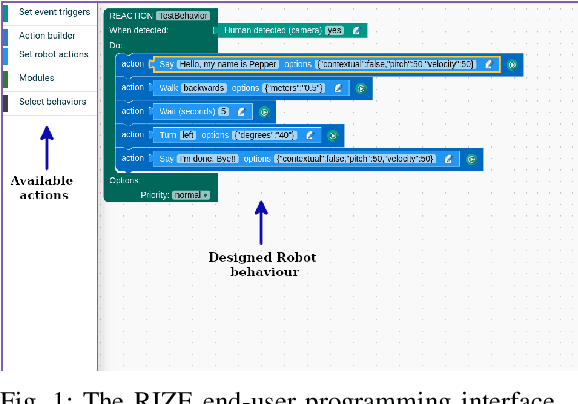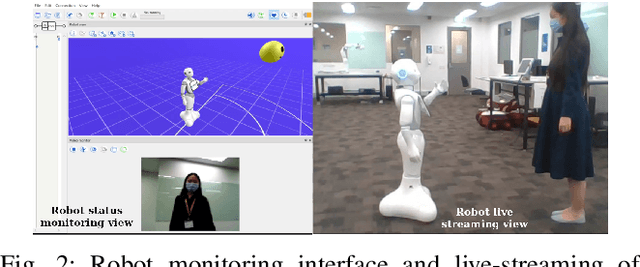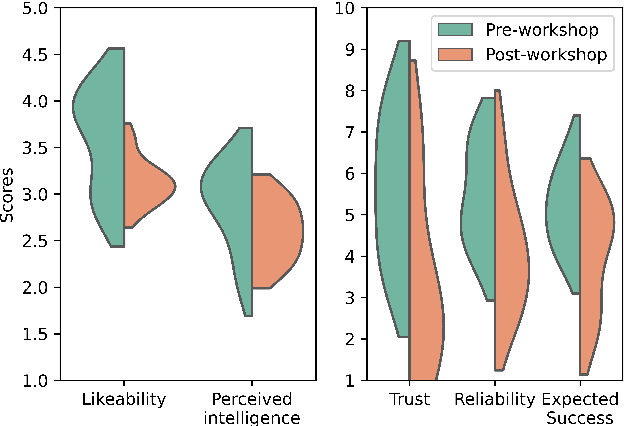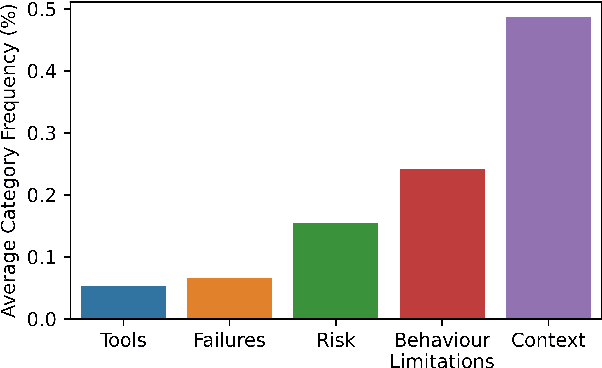Leimin Tian
CSIRO Robotics, Clayton, Australia
Collaborative Object Handover in a Robot Crafting Assistant
Feb 27, 2025



Abstract:Robots are increasingly working alongside people, delivering food to patrons in restaurants or helping workers on assembly lines. These scenarios often involve object handovers between the person and the robot. To achieve safe and efficient human-robot collaboration (HRC), it is important to incorporate human context in a robot's handover strategies. Therefore, in this work, we develop a collaborative handover model trained on human teleoperation data collected in a naturalistic crafting task. To evaluate the performance of this model, we conduct cross-validation experiments on the training dataset as well as a user study in the same HRC crafting task. The handover episodes and user perceptions of the autonomous handover policy were compared with those of the human teleoperated handovers. While the cross-validation experiment and user study indicate that the autonomous policy successfully achieved collaborative handovers, the comparison with human teleoperation revealed avenues for further improvements.
A Framework for Dynamic Situational Awareness in Human Robot Teams: An Interview Study
Jan 15, 2025



Abstract:In human-robot teams, human situational awareness is the operator's conscious knowledge of the team's states, actions, plans and their environment. Appropriate human situational awareness is critical to successful human-robot collaboration. In human-robot teaming, it is often assumed that the best and required level of situational awareness is knowing everything at all times. This view is problematic, because what a human needs to know for optimal team performance varies given the dynamic environmental conditions, task context and roles and capabilities of team members. We explore this topic by interviewing 16 participants with active and repeated experience in diverse human-robot teaming applications. Based on analysis of these interviews, we derive a framework explaining the dynamic nature of required situational awareness in human-robot teaming. In addition, we identify a range of factors affecting the dynamic nature of required and actual levels of situational awareness (i.e., dynamic situational awareness), types of situational awareness inefficiencies resulting from gaps between actual and required situational awareness, and their main consequences. We also reveal various strategies, initiated by humans and robots, that assist in maintaining the required situational awareness. Our findings inform the implementation of accurate estimates of dynamic situational awareness and the design of user-adaptive human-robot interfaces. Therefore, this work contributes to the future design of more collaborative and effective human-robot teams.
'What did the Robot do in my Absence?' Video Foundation Models to Enhance Intermittent Supervision
Nov 15, 2024



Abstract:This paper investigates the application of Video Foundation Models (ViFMs) for generating robot data summaries to enhance intermittent human supervision of robot teams. We propose a novel framework that produces both generic and query-driven summaries of long-duration robot vision data in three modalities: storyboards, short videos, and text. Through a user study involving 30 participants, we evaluate the efficacy of these summary methods in allowing operators to accurately retrieve the observations and actions that occurred while the robot was operating without supervision over an extended duration (40 min). Our findings reveal that query-driven summaries significantly improve retrieval accuracy compared to generic summaries or raw data, albeit with increased task duration. Storyboards are found to be the most effective presentation modality, especially for object-related queries. This work represents, to our knowledge, the first zero-shot application of ViFMs for generating multi-modal robot-to-human communication in intermittent supervision contexts, demonstrating both the promise and limitations of these models in human-robot interaction (HRI) scenarios.
"One Soy Latte for Daniel": Visual and Movement Communication of Intention from a Robot Waiter to a Group of Customers
Jul 08, 2024Abstract:Service robots are increasingly employed in the hospitality industry for delivering food orders in restaurants. However, in current practice the robot often arrives at a fixed location for each table when delivering orders to different patrons in the same dining group, thus requiring a human staff member or the customers themselves to identify and retrieve each order. This study investigates how to improve the robot's service behaviours to facilitate clear intention communication to a group of users, thus achieving accurate delivery and positive user experiences. Specifically, we conduct user studies (N=30) with a Temi service robot as a representative delivery robot currently adopted in restaurants. We investigated two factors in the robot's intent communication, namely visualisation and movement trajectories, and their influence on the objective and subjective interaction outcomes. A robot personalising its movement trajectory and stopping location in addition to displaying a visualisation of the order yields more accurate intent communication and successful order delivery, as well as more positive user perception towards the robot and its service. Our results also showed that individuals in a group have different interaction experiences.
Improving Visual Perception of a Social Robot for Controlled and In-the-wild Human-robot Interaction
Mar 05, 2024



Abstract:Social robots often rely on visual perception to understand their users and the environment. Recent advancements in data-driven approaches for computer vision have demonstrated great potentials for applying deep-learning models to enhance a social robot's visual perception. However, the high computational demands of deep-learning methods, as opposed to the more resource-efficient shallow-learning models, bring up important questions regarding their effects on real-world interaction and user experience. It is unclear how will the objective interaction performance and subjective user experience be influenced when a social robot adopts a deep-learning based visual perception model. We employed state-of-the-art human perception and tracking models to improve the visual perception function of the Pepper robot and conducted a controlled lab study and an in-the-wild human-robot interaction study to evaluate this novel perception function for following a specific user with other people present in the scene.
I Know Your Feelings Before You Do: Predicting Future Affective Reactions in Human-Computer Dialogue
Mar 17, 2023



Abstract:Current Spoken Dialogue Systems (SDSs) often serve as passive listeners that respond only after receiving user speech. To achieve human-like dialogue, we propose a novel future prediction architecture that allows an SDS to anticipate future affective reactions based on its current behaviors before the user speaks. In this work, we investigate two scenarios: speech and laughter. In speech, we propose to predict the user's future emotion based on its temporal relationship with the system's current emotion and its causal relationship with the system's current Dialogue Act (DA). In laughter, we propose to predict the occurrence and type of the user's laughter using the system's laughter behaviors in the current turn. Preliminary analysis of human-robot dialogue demonstrated synchronicity in the emotions and laughter displayed by the human and robot, as well as DA-emotion causality in their dialogue. This verifies that our architecture can contribute to the development of an anticipatory SDS.
Crafting with a Robot Assistant: Use Social Cues to Inform Adaptive Handovers in Human-Robot Collaboration
Jan 07, 2023



Abstract:We study human-robot handovers in a naturalistic collaboration scenario, where a mobile manipulator robot assists a person during a crafting session by providing and retrieving objects used for wooden piece assembly (functional activities) and painting (creative activities). We collect quantitative and qualitative data from 20 participants in a Wizard-of-Oz study, generating the Functional And Creative Tasks Human-Robot Collaboration dataset (the FACT HRC dataset), available to the research community. This work illustrates how social cues and task context inform the temporal-spatial coordination in human-robot handovers, and how human-robot collaboration is shaped by and in turn influences people's functional and creative activities.
Aligning Robot's Behaviours and Users' Perceptions Through Participatory Prototyping
Jan 11, 2021



Abstract:Robots are increasingly being deployed in public spaces. However, the general population rarely has the opportunity to nominate what they would prefer or expect a robot to do in these contexts. Since most people have little or no experience interacting with a robot, it is not surprising that robots deployed in the real world may fail to gain acceptance or engage their intended users. To address this issue, we examine users' understanding of robots in public spaces and their expectations of appropriate uses of robots in these spaces. Furthermore, we investigate how these perceptions and expectations change as users engage and interact with a robot. To support this goal, we conducted a participatory design workshop in which participants were actively involved in the prototyping and testing of a robot's behaviours in simulation and on the physical robot. Our work highlights how social and interaction contexts influence users' perception of robots in public spaces and how users' design and understanding of what are appropriate robot behaviors shifts as they observe the enactment of their designs.
Polarity and Intensity: the Two Aspects of Sentiment Analysis
Jul 04, 2018



Abstract:Current multimodal sentiment analysis frames sentiment score prediction as a general Machine Learning task. However, what the sentiment score actually represents has often been overlooked. As a measurement of opinions and affective states, a sentiment score generally consists of two aspects: polarity and intensity. We decompose sentiment scores into these two aspects and study how they are conveyed through individual modalities and combined multimodal models in a naturalistic monologue setting. In particular, we build unimodal and multimodal multi-task learning models with sentiment score prediction as the main task and polarity and/or intensity classification as the auxiliary tasks. Our experiments show that sentiment analysis benefits from multi-task learning, and individual modalities differ when conveying the polarity and intensity aspects of sentiment.
 Add to Chrome
Add to Chrome Add to Firefox
Add to Firefox Add to Edge
Add to Edge